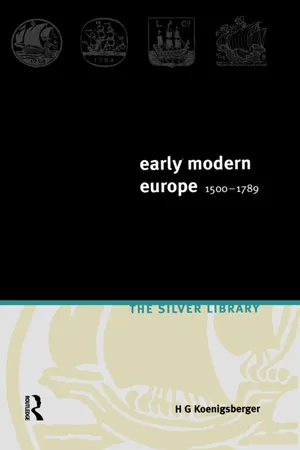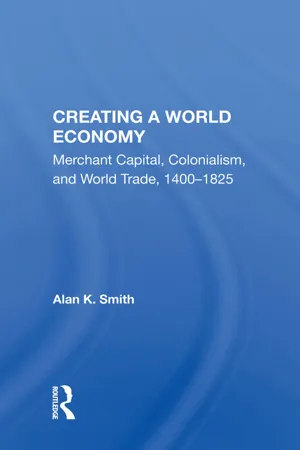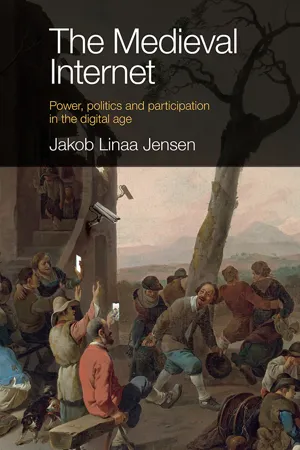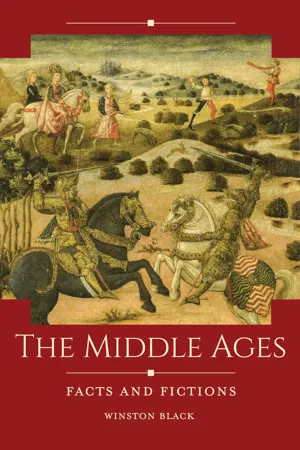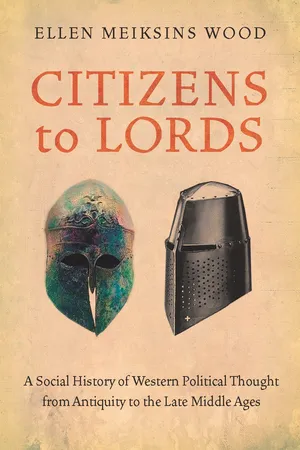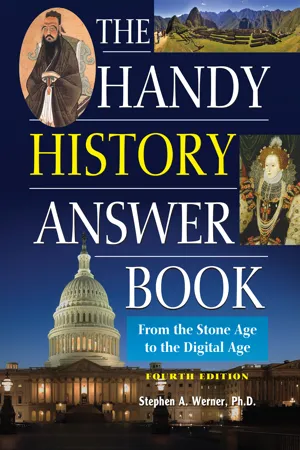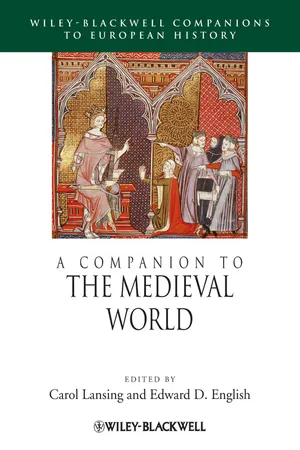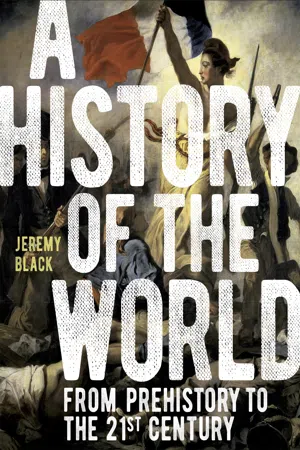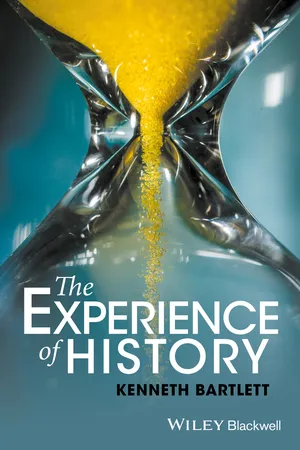History
Medieval Europe
Medieval Europe refers to the period in European history from the fall of the Western Roman Empire in the 5th century to the beginning of the Renaissance in the 15th century. It was characterized by feudalism, the dominance of the Catholic Church, and significant cultural, social, and economic changes. This era saw the development of chivalry, Gothic architecture, and the spread of universities.
Written by Perlego with AI-assistance
Related key terms
11 Key excerpts on "Medieval Europe"
- No longer available |Learn more
The Modernization of the Western World
A Society Transformed
- John McGrath, Kathleen Callanan Martin(Authors)
- 2017(Publication Date)
- Routledge(Publisher)
4 Europe in the Middle Ages Medieval Society John McGrath Key Terms bourgeoisie, estate system, ethos, feudalism, fief, manorialism, national monarchies, nobility, peasants, regular clergy, secular clergy, serf, systemic social change, vassal We generally define the medieval period of European history, or the “Middle Ages,” as the era between the fall of the Roman Empire and the beginning of the early modern period. This covers a span of about a thousand years, between roughly 500 and 1500 CE. In past centuries, scholars considered this mostly as an era of decline between the civilizations of the classical era and the Renaissance, and the terms “Middle Ages” and “medieval” had somewhat negative connotations. In more recent years, however, we have come to appreciate that the Middle Ages was a unique period of time in its own right that provided the foundation of modern Western civilization. When dealing with such a long period of time, it is often convenient to further divide the Middle Ages into three separate periods, each with a somewhat distinctive historical character. In a sense, the Middle Ages began after the gradual disintegration of Roman Empire’s unifying influence, which led to a period of disorder and insecurity lasting several hundred years. This is often referred to as the early Middle Ages (ca. 500–1000 CE), and sometimes even as the “Dark Ages,” due to the relative lack of written historical evidence that makes details hard to come by. The early Middle Ages featured large-scale movements of peoples, some entering Europe from the outside, and other groups migrating within Europe. Many of these migrations displaced other groups, who in turn displaced others as they established themselves in new lands. During this era, Roman, Celtic, Germanic, Slavic, and other peoples split apart, intermarried, and founded new settlements - eBook - ePub
- H.G. Koenigsberger(Author)
- 2014(Publication Date)
- Routledge(Publisher)
Some economic historians, and especially Marxists, have also seen the late fifteenth and early sixteenth centuries as decisive in the development of capitalism and of the bourgeoisie, a non–feudal, market orientated class. Among the economic historians, too, there are many different views. The Marxists, in particular, have complicated the problem by their use of the term feudalism. They use it not only for the period from the ninth to the thirteenth century and for an organisation of society which depended on fealty and military service (rendered by knights to their princes in return for a fief, a piece of land), and on serfdom and labour services (rendered by peasants to their lords in return for their holdings); the Marxists have extended the term feudalism to cover any society dominated by large landowners and in which the peasants, without being necessarily unfree of performing labour services, are economically and socially dependent on the land owners. On this definition, feudalism is then held to have persisted up to at least the French Revolution, at the end of the eighteenth century, and in Russia and other parts of the world until the revolutions of the twentieth century.This History uses the word feudalism in the traditional way, accepts the conventional periodization of the end of the Middle Ages (but without accepting the humanist view of the period as culturally dark and barbaric) and divides the modern age into an ‘early modern’ period, up to the French Revolution, and a ‘modern’ period, from the end of the eighteenth century to the present.The economic condition of Europe in 1500The economic history of Europe in the Middle Ages had shown distinct rhythms of expansion and contraction. From about the year AD 1000, when the West finally emerged from the age of invasions by Arabs, Vikings and Magyars, Europe experienced a long period of expansion which lasted about three hundred years. Population increased, much new land came under cultivation, towns and cities were founded, and the overall wealth of European society and the standard of living of at least a minority rose steadily. From the early fourteenth century this movement was reversed. Then, in the Black Death, the great plague which raged in Europe from 1348 to 1350, the Continent lost a quarter or more of its population. The area of cultivated land, the size of cities, the volume of trade all shrank drastically, although the standard of living of the mass of the population probably rose.From about the middle of the fifteenth century, and more clearly from around the year 1500, there began a new period of expansion. The epidemics of plague became less frequent and a little less deadly. Population increased again. Deserted fields were ploughed up again and new fields were wrested from forest and marsh. People built new houses on the empty spaces the plagues had left inside the city walls, and soon many towns spilt over their old confines. Expanding trade provided new wealth for merchants, shipowners and bankers. It also provided new wealth for princes and soldiers who used it the way they had always done, to extend their dominions by military conquests or to defend themselves against those who tried to do it at their expense. - eBook - ePub
Creating A World Economy
Merchant Capital, Colonialism, And World Trade, 1400-1825
- Alan K. Smith(Author)
- 2019(Publication Date)
- Routledge(Publisher)
3 Medieval EuropeIn its premodern phase, Europe passed through a number of cycles. As was the case of the wider world, it experienced both peaks and troughs. It differed, however, insofar as its peaks were less majestic and its low points more devastating, occasionally bordering on the disastrous. Nevertheless, the factors responsible for both the successes and the failures Europe underwent were frequently quite similar to those that took place elsewhere. Yet despite the similarities in the historical processes that dominated both spheres during much of their history, as Europe edged toward what would become its early-modern period in the years after 1500, its experience began to diverge both from its own past and from the path followed in the wider world. In the absence of a centralization capable of imposing unitary structures, free rein was given to a diversity of competing forces. Although many of the different groups ultimately pursued goals in conflict with one another, obtaining the desired ends frequently required cooperation, concession, and compromise among interests that otherwise had little in common. Because the combinations that emerged differed from one region to another and the weight and power of any given interest might vary significantly across the Continent, Europe came to be composed of various syntheses of social, political, and economic systems. Although as Europe prepared to enter its early-modern phase it was unclear which, if any of them, would ultimately prove successful in leading the way toward sustained growth, the Middle Ages provided the nurturing ground for those forces and combinations that would overcome seemingly insuperable obstacles.The Antecedents
The period that preceded the European Middle Ages was one of great political oscillation. Ushered in by the hegemony associated with the Roman Empire, it subsequently covered an era that has come to be known as the Dark Ages, experienced an ill-fated attempt to recapture the glories of Rome, and finally ended in a devastating series of invasions staged from the fringes of the Continent itself. Although the rise and fall of dynasties during this era have captured much attention in the scholarly literature, production and the productive forces that underwrote the social formation were important determinants of the events that took place. For, unlike the situation in the wider world, where the expansion of the material base went hand in hand with the growth of larger social formations, the outstanding feature of early European history was the low level of productivity that underlay social structures. This, in turn, was related to the relations of production, which were often characterized by their servile nature. Thus, despite ephemeral success in consolidating political authority, prior to the late Middle Ages Europe was unable to sustain the limited momentum that, on occasion, it was able to generate. - eBook - ePub
The Medieval Internet
Power, politics and participation in the digital age
- Jakob Linaa Jensen(Author)
- 2020(Publication Date)
- Emerald Publishing Limited(Publisher)
In terms of its material life, medieval societies were characterised by a feudal economic structure, which was exhaustively analysed in the classic study by Marc Bloch (1961). It was based on a chain of exploiters and exploited. The kings depended on the vassals for their wealth, who in turn were invested with their fiefs, officially, by the monarch. The holders of these fiefs were, in turn dependents of the local feudal lords – who were often wealthier and more powerful than kings – who themselves appropriated a large share of the produce of the peasants, the majority of the population, who were firmly at the bottom of the societal pyramid and attached by law to the land. The overlapping forms of dependence made for a formally stagnant society in economic terms, as the incentives for those in power were all about conserving the existing economic and political order. However, as we shall see, it was also a time of new inventions, social and cultural development and in many ways the Middle Ages paved the road for the age of enlightenment and later modernity.Medieval Society
Imagine you are in the year 1220. It is exactly 800 years ago as I write this. You are living in the centre of Europe. 1220 is in the middle of the époque historians refer to as ‘high Middle Ages’. Most of the concepts and phenomena we associate with medieval times have crystalised into culture-shaping forces: Knight orders, the crusades, fortified castles, trenches and endless fights between small kingdoms or fiefdoms struggling for power and dominance with each other. Europe is, nominally, wholly Catholic, although there is a lot of evidence that popular beliefs were in continuity with ancient popular beliefs regarding many spiritual forces. Notre Dame de Paris, the paradigmatic Gothic cathedral, was started in 1160 and was being completed. They had been building Chartres for 20 years, and other great cathedrals were going up in Northern Europe. The population is growing, having recovered from the early ‘barbarian’ period’s invasion and the decay of infrastructure. Forests are being cleared and swamps drained. There is no hint, yet, of the demographic disaster yet to come – the Black Death that swept Europe in the fourteenth century. But people in 1220 were not unfamiliar to outbreaks of horrible diseases and often a sudden and unpleasant death. - eBook - ePub
The Middle Ages
Facts and Fictions
- Winston Black(Author)
- 2019(Publication Date)
- ABC-CLIO(Publisher)
“Medieval” is a problematic term because it refers not to what defines it, but to something it is not: it is not classical Greece and Rome and it is not the Italian Renaissance, but a “middle age” resting uneasily between them and lacking definition. Nobody living in the Middle Ages, therefore, would understand the concept of “medieval.” The term itself appeared only in 1604, in the neo-Latin construction medium aevum (“middle age”), which then created the adjective mediaevalis (“medieval”). (It can be confusing that only English makes the term plural, Middle Ages, while other European languages follow the Latin in keeping it singular: moyen âge, Mittelalter, medio evo, and so on.) The problems increase when we refer to the medieval period as the “Dark Ages.” It is obviously a loaded term, one meant to trigger strong emotions. It is “dark” only in comparison to something “light,” but that age or culture of light can change depending on your perspective. For some, the Middle Ages are dark because of the loss of the supposed splendors of classical Roman culture. The historian Edward Gibbon, in his monumental work The Decline and Fall of the Roman Empire, considered the second century CE in the Roman Empire (specifically the reigns of the “Five Good Emperors,” 96–180 CE) to be the happiest and most prosperous age of humankind. Therefore he portrays all of the events that came after that period as increasingly unhappy and eventually “dark”—dark, that is, until the rise of enlightened modernity in his own time. For many other historians, the Middle Ages are dark because they have not yet become the Italian Renaissance of Petrarch, Michelangelo, and Leonardo, with their focus on individualism, humanism, naturalistic art, and three-dimensional sculpture. It is usually a combination of these two approaches (the loss of Roman culture and the failure to be the Renaissance) that is found in recent works of popular history - eBook - ePub
Citizens to Lords
A Social History of Western Political Thought from Antiquity to the Late Middle Ages
- Ellen Meiksins Wood(Author)
- 2011(Publication Date)
- Verso(Publisher)
4 THE MIDDLE AGES From Imperial Rome to ‘Feudalism’ ‘[T]here seems little doubt,’ writes the eminent medieval historian, Rodney Hilton,that peasantries were the basis of the ancient civilizations out of which most European feudal societies grew . . . In fact, viewed from the standpoint of this most numerous class of rural society, the difference between late Roman and early medieval civilization may not have been all that easy to discern.1Yet, despite this fundamental continuity, some conventions of Western culture have produced a sense of profound rupture between classical antiquity and ‘feudal’ society, as the western empire descended into the ‘Dark Ages’ after the ‘decline and fall’. Enlightenment conceptions of progress and classical political economy, for instance, tended to view the Middle Ages as an interruption in the progressive development of Western civilization from its roots in classical antiquity, a hiatus that delayed the inevitable triumph of rationalism and/or ‘commercial society’ after their promising beginnings in the ancient Mediterranean. The natural course of history, it seems, resumed only with the Renaissance.Feudalism, in these conventions, often appears to come out of nowhere, or at best from outside, imported into the imperial territories by barbarian invaders. When the feudal order has been presented as a synthesis of Roman and barbarian elements, the Roman past still seems to be a hollow memory rather than a living social legacy. More recent scholarship has done much to correct this disconnected view of history. But the legacy of old conventions has been hard to uproot, not least because the continuities are more visible from the vantage point of peasants, and history has seldom been recorded from the standpoint of the peasantry. Even historians who are more sceptical of the ‘decline and fall’ as rupture, or question ‘Germanic’ influences, or reject the idea of a medieval hiatus by finding the roots of modernity in the Middle Ages, have sometimes tended to emphasize the void left by a dying Roman Empire, which was to be filled by a thoroughly new feudal order, whether transmitted by barbarian invasions or born out of the wreckage of empire, the chaos of social disorder and war. - eBook - ePub
The Handy History Answer Book
From the Stone Age to the Digital Age
- Stephen A. Werner(Author)
- 2020(Publication Date)
- Visible Ink Press(Publisher)
To better understand this period, one must note that most people, but not all, thought the world was flat. They also thought that the sun, moon, and stars were small objects a few miles up in the air. Most people had no idea that Earth was a planet in a vast, vast universe. So, most people believed Heaven was “up there, beyond the stars” and that Hell was down below Earth. By the Middle Ages, the concepts of Heaven and Hell were well developed.During the Middle Ages, scholars argued that the meaning of life on Earth lay primarily in its relation to an afterlife. Therefore, they believed that art for its own sake had no value, and they even frowned on the recognition of individual talent. For this reason, many of the great artworks of the Middle Ages were created anonymously.What are the characteristics of medieval times?Although the Middle Ages were shadowed by poverty, ignorance, economic chaos, bad government, and the plague, it was also a period of cultural and artistic achievement. For example, the university originated in Medieval Europe (the first university was established in 1158 in Bologna, Italy). The period was marked by the belief, based on the Christian faith, that the universe was an ordered world, ruled by an infinite and allknowing God. This belief persisted even through the turmoil of wars and social upheavals, and it is evident in the soaring Gothic architecture (such as the Cathedral of Chartres, France), the poetry of Dante Alighieri (1265–1321), the philosophy of St. Thomas Aquinas (1225–1274), the Gregorian chant, and the music of such composers as Guillaume de Machaut (c. 1300–1377).What was the structure of feudal society?With the breakup of the Roman Empire, a system called feudalism developed. What follows is a simplified description of the feudal social structure. It was often more complicated than this and often varied from place to place.Kings - eBook - ePub
- Carol Lansing, Edward D. English, Carol Lansing, Edward D. English(Authors)
- 2012(Publication Date)
- Wiley-Blackwell(Publisher)
Part VII The European Middle AgesPassage contains an image Chapter Twenty-seven Medieval Europe in World History R. I. Moore
The Master Narrative of Academic History
The history of medieval history in the nineteenth and twentieth centuries might be written as that of a series of attempts to secure for it a place in the Master Narrative (as it will be called in this chapter) whose canonization was the founding achievement of academic history in the second half of the nineteenth century. The undisputed basis of that history at least until the 1960s, the Master Narrative told how human achievement had reached its peak in the liberal democracies of the industrial age. Both democracy and capitalist industrialism (which were taken to be inseparable in the authorized version, though not in its Marxist variant) were attributable to the special qualities of European, or Western, or Christian Civilization, and in particular to its synthesis of the rational and democratic traditions of the classical civilization of the ancient Mediterranean with the spiritual power and insights of the Judeo-Christian legacy. This synthesis had been perfected by the Renaissance and Enlightenment, after a millennium of maturation following the decline of the ancient world. Articulated in the Age of (benign) Revolution and diffused in that of Empire, or Improvement, the resultant values imparted to the nations of Europe and the New World both the dynamism that generated world-dominating and world-transforming power and the checks and balances that restrained its exercise, contrasting markedly in both respects with the stagnant and decaying but still absolutist tyrannies of the Middle East and Asia.During the century or so of its pomp, the Master Narrative structured, with relatively minor national and regional variations, the curriculum for the teaching of history almost everywhere in the developed and much of the developing world. And not only of history, but in varying degrees of all the disciplines that conceived themselves as having developed in a historical fashion, or their subject matter as having been to any degree influenced by its historical contexts and circumstances, including those of the modern languages and literatures, even to an extent of philosophy and ethics. The social sciences too, trapped in the Master Narrative precisely because they self-consciously repudiated historical foundations and historical method, in the main accepted without serious question, even if sometimes under protest, that the ultimate achievement of human progress was the breakthrough to capitalist industrialism, which was the reward of the peculiar virtues that characterized European as opposed to other cultures – freedom, effort, thrift, enterprise, the rule of law, and so on. - eBook - ePub
The History of Democracy
A Marxist Interpretation
- Brian S. Roper(Author)
- 2012(Publication Date)
- Pluto Press(Publisher)
3
The early Middle Ages and the transition from feudalism to capitalism INTRODUCTIONThe historical narrative in Chapter 2 concluded with the overthrow of the final western Roman emperor (Romulus Augustulus) in 476 AD . This chapter provides a condensed overview of the early Middle Ages and the emergence of feudalism in Europe, emphasising the scale of the social, economic and demographic decline from 476 to 800 as well as the prevailing social forms of agricultural production that were central to the emergence of feudalism from the ninth century onwards. By the thirteenth century feudalism had, as Anderson puts it, ‘produced a unified and developed civilisation that registered a tremendous advance on the rudimentary, patchwork communities of the Dark Ages’ (1974a: 182). The substantial population growth from the tenth to the thirteenth centuries, including the re-emergence of large towns, and the increasing weight of military, state and religious requirements, placed feudal agricultural production under mounting pressure. A generalised crisis of feudalism ensued, with famine becoming widespread during the early decades of the fourteenth century, followed by the Black Death that swept across Europe recurrently from the first outbreak of the bubonic and pneumonic plague in 1347–9 to the mid-fifteenth century.This prolonged crisis ultimately had different outcomes in Eastern Europe, France and England (Brenner, 1985, 1990, 2007). In Eastern Europe the outcome was intensified exploitation of serfs and peasants by noble landlords, in France it involved the growth of an absolutist tax-gathering and office-providing state, and in England it gave rise to capitalist relations of production in the countryside between noble landlords, capitalist tenant farmers and agricultural wage-labourers. This set of developments is the focus of the second section of the chapter. - eBook - ePub
A History of the World
From Prehistory to the 21st Century
- Jeremy Black(Author)
- 2018(Publication Date)
- Arcturus(Publisher)
Chiesa di Sant’ Agostino (Church of St Augustine) in San Gimignano in Italy, Benozzo Gozzoli painted a fresco showing San Sebastian intervening to protect the city against the 1464 plague epidemic. Such beliefs remained important, and a major part of the ritual of particular communities and of their sense of identity.Feudalism
The dominant system of political control and social organization over much of 11th-century Western Europe was feudalism. Its essential characteristic was a personal relationship between lord and vassal, cemented in an age of homage. Vassals received land in return for providing military service, usually in the form of knights (heavy armoured cavalry). The state in the modern sense – an agreed territory with sovereign powers and with a precise relationship with citizens – did not exist. Instead, there was a series of individual rulers each effectively sovereign within his own lands, though each in turn nominally owed allegiance to a king or another ruler. The roles of land ownership and military service continued to be important in political organization for the following centuries until industrialization, urbanization, conscription and nationalism fundamentally changed the situation in the 19th century.Castles
Early castles were generally simple affairs of earth and timber construction, although they still required many man-days to construct. Timber-built forms were often of either motte (a mound of earth)-and-bailey or ringwork (enclosure) type. With time, major castles, such as the Tower of London and Krak des Chevaliers, were fortified in stone, which was resistant to fire and whose walls were harder for attackers to breach. - eBook - ePub
- Kenneth Bartlett(Author)
- 2016(Publication Date)
- Wiley-Blackwell(Publisher)
d. 814) was crowned at Rome in the old basilica of St Peter as emperor, thereby creating a new imperial order in Europe? Of course any of these dates are possible; so the point I want to make is that any beginning date of any historical period will be to a degree arbitrary. However, that arbitrary choice can help the reader understand and appreciate the intention of the historian: what she or he finds significant, or what forces drive historical change, or how time can be coherently segmented, as long as the assumptions behind those divisions are clearly revealed.So much for beginnings: what about endings? When did the Middle Ages really end? I have heard arguments for dates from the fourteenth century, based on the rise of towns and a money economy, to the seventeenth century and the beginning of the Scientific Revolution which provided a different means of assessing and acquiring knowledge. Many texts choose 1517, the year that saw Martin Luther’s successful fragmentation of Christianity from a theoretically singular Roman confession into many mutually exclusive sects. Here, too, there is no right answer, as everything depends on those initial suppositions about what constitutes a historical period. If the Middle Ages are defined, as they often are, as the Age of Faith, then structural changes in the Church are of great significance, as are elaborations of theology; consequently, Luther’s revolt is a reasonable choice. But, if you see the medieval world as a set of broader beliefs, methods, and structures, founded on an acceptance of divine involvement in human affairs, then the publication of René Descartes’ (1596–1650) Discourse on Method of 1653 is a very plausible terminus because after the emergence of scientific method the ballast in the European mind shifted fundamentally, leading to a very different view of the universe and mankind’s place in it.Nevertheless, an Economic History of the Middle Ages might well begin with the establishment of landholding patterns that developed into feudalism. This would take the Middle Ages back into the final years of the late Roman Empire. Similarly, the choice of a terminal date could be any number of economic events or changes from the introduction of the gold florin by Florence in 1252 or the capture of Constantinople by the Turks in 1453, thereby complicating the European control of Mediterranean trade, or even Columbus’s first voyage to the New World in 1492, an event that signalled the shift of the economic heart of Europe from the Mediterranean to the Atlantic seacoast. A professional historian can argue for any of these dates, and all of them would be useful, provided again that the author’s intentions are made manifest in these choices.
Index pages curate the most relevant extracts from our library of academic textbooks. They’ve been created using an in-house natural language model (NLM), each adding context and meaning to key research topics.

